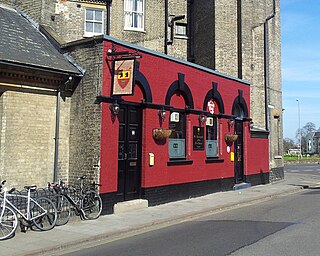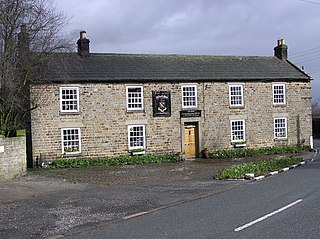
A pub is in several countries a drinking establishment licensed to serve alcoholic drinks for consumption on the premises. The term first appeared in England in the late 17th century, to differentiate private houses from those open to the public as alehouses, taverns and inns. Today, there is no strict definition, but CAMRA states a pub has four characteristics:
- is open to the public without membership or residency
- serves draught beer or cider without requiring food be consumed
- has at least one indoor area not laid out for meals
- allows drinks to be bought at a bar
J D Wetherspoon is a pub company operating in the United Kingdom and Ireland. The company was founded in 1979 by Tim Martin and is based in Watford. It operates the sub-brand of Lloyds No.1 bars, and 56 Wetherspoon hotels. Wetherspoon is known for converting unconventional premises, such as former cinemas and banks, into pubs. The company is publicly listed on the London Stock Exchange and is a constituent of the FTSE 250 Index.
A pub crawl is the act of visiting multiple pubs or bars in a single session.

Bishop's Waltham is a medieval market town situated at the source of the River Hamble in Hampshire, England. It has a foot in the South Downs National Park and is located at the midpoint of a long-established route between Winchester and Portsmouth. It is home to the ruins of Bishop's Waltham Palace, a Scheduled Ancient Monument under English Heritage management, and a well-preserved high street with many listed buildings which now house independent shops.

Radegund was a Thuringian princess and Frankish queen, who founded the Abbey of the Holy Cross at Poitiers. She is the patroness saint of several churches in France and England and of Jesus College, Cambridge.

Pub names are used to identify and differentiate traditional drinking establishments. Many pubs are centuries old, and were named at a time when most of their customers were illiterate, but could recognise pub signs. The use of signage was not confined to drinking establishments. British pubs may be named after and depict anything from everyday objects, to sovereigns, aristocrats and landowners. Other names come from historic events, livery companies, occupations, sports, and craftsmen's guilds. One of the most common pub names is the Red Lion. This list contains both modern and historical examples.

The Bartons Arms is a public house in the High Street in the Newtown area of Aston, Birmingham, England. Under new management as of August 2024.

The Champion of the Thames is a pub in King Street, Cambridge, England. The pub's name derives from an oarsman who won a sculling race on the Thames before moving to Cambridge in 1860. He required that all mail to him be addressed to "The Champion of the River Thames, King Street, Cambridge". The rowing connection continues, the Champion of the Thames rowing club being sponsored by the pub.

St Radegund is a pub in King Street, Cambridge, England. It is named after St Radegund, a Frankish saint associated with the nearby Jesus College.

Jesus Lane is a street in central Cambridge, England. The street links with the junction of Bridge Street and Sidney Street to the west. To the east is a roundabout. To the south is King Street, running parallel with Jesus Lane and linking at the roundabout. The road continues east as Maid's Causeway and then Newmarket Road east out of Cambridge. To the north is Victoria Avenue between Jesus Green to the west and Midsummer Common to the east. Also to the north near the western end is Park Street, location of the ADC Theatre. To the south is Short Street, quickly leading into Emmanuel Road past Christ's Pieces.
O'Neill's is an Irish-themed pub chain with 49 outlets in the United Kingdom. The chain is operated by Mitchells & Butlers, one of the largest pub companies in the UK. Pubs are located across the whole of the UK, except for Northern Ireland, where there are none.

The Pride of Spitalfields is a public house at 3 Heneage Street in Spitalfields in the East End of London, just off Brick Lane. It was associated with a Jack the Ripper suspect.

This is an index of drinking establishment-related articles.

The Drewe Arms is a Grade II* listed public house on the north side of The Square in Drewsteignton, Devon.

The Bridge Inn is a Grade II listed public house at Bridge Hill, Topsham in the county of Devon, England. Mentioned as a dwelling in Domesday Book, the building was largely constructed in the 18th century of cob and stone, with a 19th-century brick addition. Queen Elizabeth II visited the inn on 27 March 1998, her first official visit to a pub.

The Milbank Arms is a Grade II listed public house at Barningham, County Durham. Built in the early 19th century, it spent a period as a hotel before converting to a public house. It was one of the last public houses in the country to not include a bar counter when one was fitted in 2018. The public house, and former hotel, are named after local land owning family, the Milbanks, who have recently taken over the license.

The Gladstone Arms is a public house in Lant Street in the Borough – the Southwark district of London. It is also known as The Glad. Built on the site of a Victorian pub, the current building was constructed in the 1920s. It has been threatened by redevelopment but its popularity as a meeting place and great live music venue have caused it to be recognised as an asset of community value.















